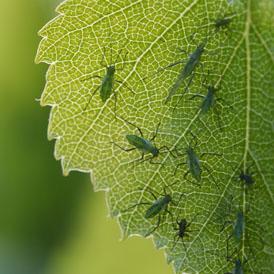Greenfly swarms torment farmers, shoppers – and tennis stars
Greenflies have descended on gardens, farmers’ fields and city centre shoppers across the UK. Even Wimbledon was hit by the swarms, which experts say are the biggest for years.

Rafael Nadal was forced off court during a practice session on Saturday as clouds of the insects, also known as aphids, descended on SW19.
Commentators Sue Barker and John McEnroe mentioned the unusual numbers of greenfly buzzing around Centre Court before the Ladies’ final, and Britain’s Liam Broady and his boys’ final opponent Luke Saville were both seen swatting the bugs away with their racquets between points.
There were also reports of greenfly harrassing shoppers in Leicester city centre on Sunday, with hundreds of pedestrians forced to fight their way through clouds of aphids.
One man was quoted as saying: “There were so many of them it looked like it was raining.”
Gardeners have been complaining on internet forums about seeing huge numbers of aphids descending on their plants. But evidence for a population explosion is not merely anecdotal.
Researchers at the Rothamsted Insect Survey, who carry out national surveys of pest numbers for the Government’s Home Grown Cereals Authority, are warning farmers about huge increases in greenfly.
Their latest report shows that numbers of the most numerous cereal aphid species are many times higher than last year and well ahead of the average for the last 10 years.
Biggest swarms for years
Lead scientist Dr Richard Harrington told Channel 4 News he believed this year’s swarms were the biggest for five or six years, and numbers will stay high for the next few weeks until the end of the cereal harvest.
But the population explosion is not expected to reach the levels of 1979, when clouds of flies forced holidaymakers to abandon Britain’s beaches, he added.
Dr Harrington blamed the rise on the cold winter, which meant aphid numbers were abnormally low in the spring.
That meant populations of the insects that feed on them, like ladybirds, lacewings and hover flies, were weakened, so when the greenfly made a comeback after the hot late spring there were fewer natural predators around.
A single aphid could theoretically reproduce so many times that it could cover the entire surface of the earth 150km deep. Dr Richard Harrington
And the pests don’t need much of a head start to trigger a population explosion, Dr Harrington explained. Aphids reproduce asexually and a single female produces an average of 50 live young in one brood.
The young greenfly can reach sexual maturity in as little as a week, and a single insect can produce 50 generations in a lifetime.
Dr Harrington said: “I’ve calculated that a single aphid could theoretically reproduce so many times that it could cover the entire surface of the earth 150km deep. Of course, there are lots of reasons why that doesn’t happen, but it shows their reproductive potential.”
He added: “There are a lot about right now. It’s been noticed quite widely and they can be a bit of a nuisance. Some of the garden aphids are really quite abundant this year, and I’m sure the gardeners will be having a bit of a moan.
“But as far as the huge clouds of insects that people are really noticing, it’s the cereal aphids that we are talking about.”

Foreign invader
Some naturalists say greenfly numbers could be affected by the decline in native species of ladybird, one of the main aphid predators.
The UK Ladybird Survey says increasing dominance of the Asian harlequin, a non-native ladybird species that first arrived in Britain in 2004 and has been spreading ever since, poses a threat to the survival of all the UK’s 46 native species.
The survey says the harlequin is the most invasive ladybird on the planet, easily able to outperform native ladybirds in hunting greenfly.
But when it can’t find enough greenfly to eat, it preys on the larvae of other flies that eat aphids, and scientists are researching what the long-term effects on pest numbers could be if the harlequin wipes out its rivals.
Duncan Sivell, biodiversity officer at the insect conservation trust Buglife, said he believed the harlequin had been deliberately released in Kent by growers with pest control problems – a move he described as “a very dodgy thing to do”.
He said harlequins reproduce more often than native ladybirds, so their numbers can grow quickly, although it is too early to say whether the invader is responsible for the long-term decline in native species.